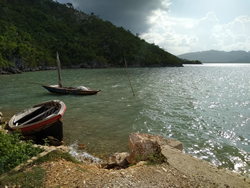Baradères
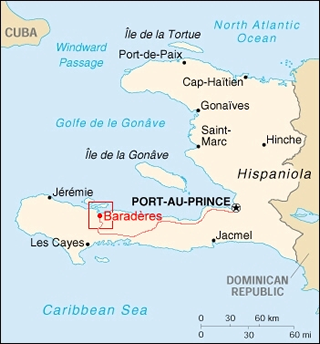 Haiti faces extreme challenges of injustice and poverty. There are lots of statistics available to document the struggles that Haitians face in sustaining their families and educations their children.
Haiti faces extreme challenges of injustice and poverty. There are lots of statistics available to document the struggles that Haitians face in sustaining their families and educations their children.
But hand in hand with our brothers and sisters in Baradères, we are making a difference for thousands of children and their families.
The place
Baraderès is on the north coast of Haiti's western peninsula, about 135 miles west of Port-au-Prince. Driving takes 6 or more hours.
The map shows approximate route of road travel between Baradères and Port-au-Prince.
Our relationship is actually with a region of roughly 25 square miles in the northernmost terminus of the road shown on the map. The road ends at the Baradères town square. Until the August 14, 2021, earthquake, St. Pierre church stood over the town square. Click here to view the area within the red square.
Most Haitian roads are in poor condition, and Baradères only has only two significant road connecting it to the world. One road, exiting the town northwards to the coast, is virtually undriveable.
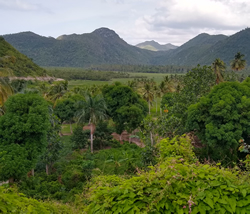 The other road, through the mountains south of town, is steep, stony,
eroded, narrow and deeply rutted. Though partially paved in places, it is passable only by high-clearance
four-wheel drive vehicles and motorbikes.
The other road, through the mountains south of town, is steep, stony,
eroded, narrow and deeply rutted. Though partially paved in places, it is passable only by high-clearance
four-wheel drive vehicles and motorbikes.
St. Pierre’s parish boundaries comprise the town of Baradères (population about 50,000) and about 18 small remote rural villages. The parish was founded in 1872, according to Haiti Référence.
Primary occupations in the parish are subsistence farming and sharecropping—on land owned by wealthy people in Port au Prince and Les Cayes, a city about 30 miles south (3 hours' drive).
Physicians from St. John's parish who traveled to Baradères in 1996 made an informal study of malnutrition, and found the rate very high among children in particular.
 Today, Baradères still has almost no publically
available electricity. A few residents use small generators or solar power.
Fuel is prohibitively costly. There are no gas stations.
Today, Baradères still has almost no publically
available electricity. A few residents use small generators or solar power.
Fuel is prohibitively costly. There are no gas stations.
A few homes in Baradères have running water piped from the single town well installed in 2000. Spigots near the town square provide the only publically available source of this water. Water pre-treatment is rudimentary at best, and there is no waste treatment. Most livestock—chiefly chickens and goats—roam freely.
A telephone line was installed in Baradères in 1998, but it has not been functional for years. Now it is obsolete; many people own cell phones.
Sharecropper income is less than $200 per year. Some farmers bring wares to sell or—mostly—barter at the outdoor market in Baradères. The town also has some small shops.
Sharecroppers typically have small gardens where they grow some of their own food.
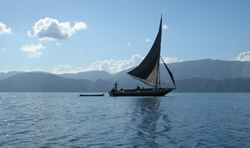 Most of the villages within the
parish are accessible only by foot, canoe or donkey. All but one are in narrow valleys or steep
mountainous areas. The exception, Grand Anse, is a fishing village on the
coast of the peninsula across the Bay of Baradères.
Most of the villages within the
parish are accessible only by foot, canoe or donkey. All but one are in narrow valleys or steep
mountainous areas. The exception, Grand Anse, is a fishing village on the
coast of the peninsula across the Bay of Baradères.
The Bay does not support a thriving fishery, probably due to overuse, sedimentation and pollution. Fishermen in Grand Anse transport most of their ocean catch by boat to sell in Miragoane, about 40 miles east.
Haiti by the numbers
CIA World Fact Book
United Nations Data
World Health Organization
Pan American Health Organization
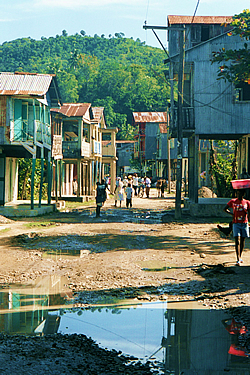 Main street Baradères, 2001.
Main street Baradères, 2001.
